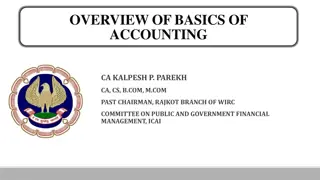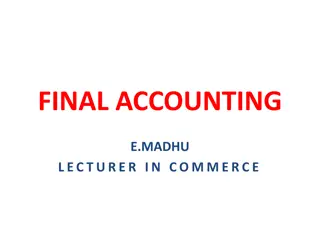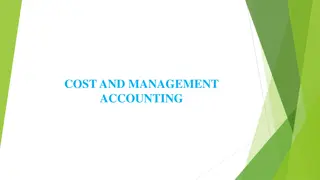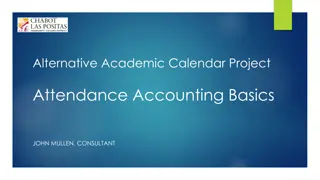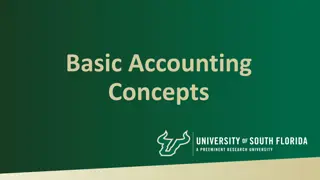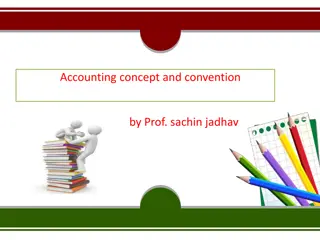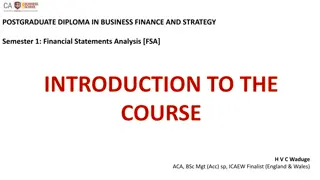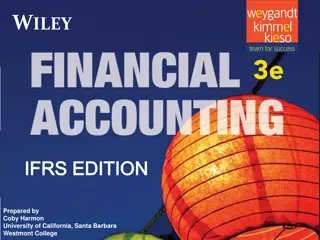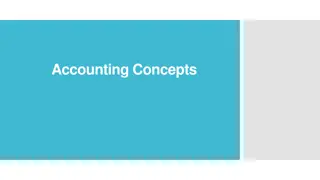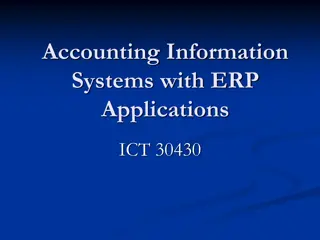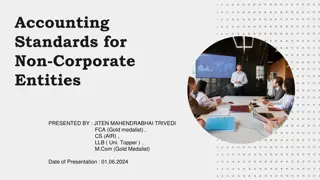Financial Accounting Concepts and Standards Explained
This content provides detailed explanations of key financial accounting concepts such as accrual accounting, matching concept, FASB standards, and revenue recognition guide. It also presents questions related to income per crocodile, revenue timing rules, and methods of revenue recognition based on specific conditions.
Download Presentation

Please find below an Image/Link to download the presentation.
The content on the website is provided AS IS for your information and personal use only. It may not be sold, licensed, or shared on other websites without obtaining consent from the author.If you encounter any issues during the download, it is possible that the publisher has removed the file from their server.
You are allowed to download the files provided on this website for personal or commercial use, subject to the condition that they are used lawfully. All files are the property of their respective owners.
The content on the website is provided AS IS for your information and personal use only. It may not be sold, licensed, or shared on other websites without obtaining consent from the author.
E N D
Presentation Transcript
Accrual Concept Accrual accounting requires that revenues and expenses be reported when the benefits have been received or used up and not when cash is collected. Example 1: Georgia Pacific sells $100,000 in lumber to Home Depot in December 2007. Home Depot pays in January 2008. Georgia Pacific will record $100,000 in sales revenue for year 2007. Example 2: Home Depot owes employees salary for December 2007 of $250,000 which it pays on January 1 2008. It has a salary expense of $250,000 in 2007.
Matching Concept The matching concept requires that all costs past, present or future must be matched against the revenue they give rise to. A Ford dealer sells an automobile to a customer in year January 2008 that it had purchased in December 2007. Example of Past Expense: Purchase cost of the automobile from 2007. Example of Present Expense: Sales commission paid in January 2008. Example of Future Expense: Estimated warranty repairs to be done in the future.
FASB Standards v Statements Standards are issued by the Financial Accounting Standards Board and represent rules to be followed. Statements of FASB are for guidance and not mandatory rules.
Revenue Recognition Guide Most businesses typically recognize revenue at time of sale (delivery to a common carrier). Statement of Concept # 5 requires two conditions for revenue recognition: 1. When products or other assets are exchanged for cash or claims to cash. 2. When the entity has substantially accomplished what it must do to be entitled to the benefits represented by the revenues.
Question 1: Income per Crocodile Per Crocodile ? ? ? ? Sales Price Catching Expenses Shipping Expenses Collection and Bad Debts Expense Total Expenses per crocodile Net income per crocodile ? ?
Question 2: Income Under Different Revenue Timing Rules Production or Catching Basis: Delivery or Sale Basis: Collection Basis:
Question 2: What method should we use? Statement of Concept # 5 requires two conditions: Realized or realizable. Revenues and gains are realizable when related assets received or held are readily convertible to known amounts of cash or claims to cash. Earned. Revenues are considered to have been earned when the entity has substantially accomplished what it must do to be entitled to the benefits represented by the revenues.
Question 3: Balance of Lease Term MPM is suing Croc Your World for 24 months of unpaid rent the balance of the lease term Does MPM have a duty to mitigate damages? Is there is evidence of damages?
Question 4: Punitive Damages Is MPM entitled to punitive damages? Is there is evidence of damages?
Question 5: Accounting Entry Ask attorney if liability from the lawsuit is probable, reasonably possible, or remote. Recognize a contingent liability if in attorney s opinion liability is probable. What is the entry assuming 3-month vacancy?




